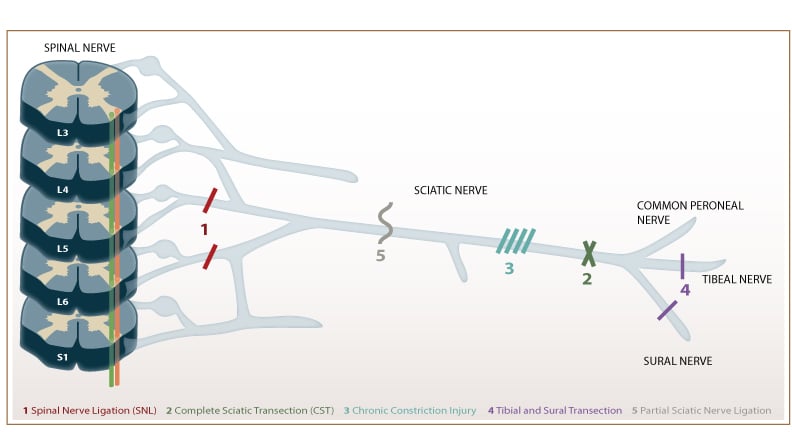6 min read

Related Posts
Assessing Subjective Pain | Preclinical Pain Studies
Rodent models of pain such as nerve injury models are important to understand the mechanisms that...
By: MD Biosciences on Aug 24, 2011 4:00:00 PM

We get a lot of questions on the various neuropathic pain models and how to choose the one that's most appropriate or a comparison of what's involved with each model (e.g. surgery, behaviors, centralization, peripheral vs central involvement etc). We thought it may be helpful to discuss the various aspects of these models to assist with the selection and understanding of the mechanisms and behaviors. Of course, it ultimately depends on the drug target and the pathway involved and we can certainly discuss individual specifics with you.
Neuropathic Pain Models
Preclinical models in pain research offer great promise for both the identification of pain mechanism and the investigation of possible therapeutic applications. Since there is not one mechanism that is responsible for generation and maintenance on neuropathic pain (NPP), it is essential to select the best model for each specific research interest or a combination of appropriate but distinct models.
At present, preclinical models for NPP cover various etiologies and are related to symptoms leading to an extensive picture of clinical NPP manifestations. The majority of these preclinical models of NPP involve traumatic injuries to peripheral nerves, nerve roots or spinal cord by transaction, ligation or compression (Fig 1). Other models are related to direct or indirect nerve inflammation, ischemia, drug toxicity or systemic metabolic disorder leading to nerve ending damage.
All of these models have been characterized by precise behavior-based evaluation using different methods of sensory stimulation. Many molecular, physiological and structural modifications have been described in these models. Most of the rodent models are described also with actual electrophysiology measurement and imaging techniques as well as genomic and proteomic screening. Over the coming weeks, we will discuss these various findings in nerve injury models.
Behavior based findings in two common preclinical Nerve Injury Models
Surgical procedures on selective spinal nerves such as the SNL model allows the direct access to sensory and motor fibers and clear segment location of injured (L5/L6) and non injured DRG (L4) and afferents. In this model the tight ligation of the L5/L6 spinal nerves results in robust and consistent sympathetic related neuropathic pain behavior including indirect signs of spontaneous pain, heat hyperalgesia, mechnical allodynia and cold allodynia.
Chronic constriction injury (CCI, also Bennet and Xie)
The CCI model is induced by applying 4 catgut loosely around the sciatic nerve. This model allows sensory testing in the hind paw as not all the sensory nerved are damages. Moderate autotomy, guarding and excessive grooming of the injured limb are reported as well as thermal hyperalgesia and mechanical allodynia were recorded. The main challenges in this model is the standardization of the loose but constrictive ligature.
The following table summarizes the behavior based response following each of the surgical-induced preclinical neuropathic pain models.
| Parameter | CST | TST | CCI | SNL | PSL |
| Autotomy | 65% | - | ~10% | ~10% | - |
| Natural Pain Behavior | Low | 0 | Significant peak at day 9 | Moderate Peak at day 16 | Low |
| Response to hot plate (duration of lifting time) | Low | Low | Significant, yet reversable with a peak at days 3-9 post surgery | Moderate persistance until day 28 | Minimal only at day 3 |
| Response to VF | Significant | Significant | Moderate | Significantly higher than other models | Significant |
| Pin Prick | Significant | Significant | Significant | Significantly higher than other models | Significant |
| Acetone Test | Significant starting from day 1 | Significant starting from day 1 | Significant starting from day 1 | Significant starting from day 1 | Significant starting from day 1 |
| Cold Plate | Moderate from day 21 | Minor from day 21 | Significant from day 1 | Moderate from day 1 | Significant peak at day 14 |
Abbreviations: CST - complete sciatic transection; TST - tibial and sural transection; CCI - chronic constriction injury; SNL - spinal nerve ligation; PSL - partial nerve ligation; VF - von frey
Hopefully this comparison of the behavioral findings for each spinal nerve injury model helps sort out the differences and similarities between models. If you would like to speak more about the models as it relates specifically to your compound, please contact us. Our scientists love talking about this stuff.
Rodent models of pain such as nerve injury models are important to understand the mechanisms that...